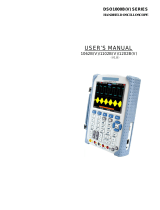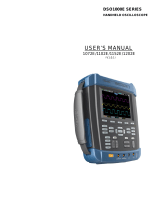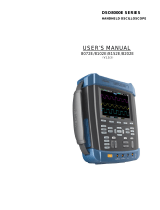Page is loading ...

CC-800 AC/DC CURRENT PROBE
OPERATOR’S MANUAL

INTRODUCTION
The multimeter/oscilloscope can directly measure the DC current of no more than 800A
and the AC current of no more than 500A through the AC/DC current probe, and the
measurement frequency is up to 5KHz. When measuring current with this current probe,
there is no need to destroy the current loop or peel off the insulating layer.
The current probe is not only suitable for the detection or monitoring of possible leakage in
the circuit, but also the extended jaw can be measured in a small gap. It should be noted
that when measuring DC current, it is necessary to adjust the zero point by operating the
zero adjustment knob.
APPLICATION PROCEDURE
1. When connecting with a multimeter, insert the GND terminal of the BNC/banana-KJJ
adapter into the COM terminal of the multimeter, and insert the other terminal of the
adapter into the V-Ω terminal. Please note that the input impedance of the multimeter
used should be at least 10K ohms.
When connecting with the oscilloscope, connect the BNC plug of the current probe to
the BNC terminal of the oscilloscope.
2. Set the power switch from the "OFF" to the range required to measure the current,
that is to say, push the switch slider to 10mV/A or 1mV/A range. When the current
probe is powered normally, the green power indicator will light up.
3. When the measured current is not greater than 20 amperes, please set the current
probe to the 10mV/A range, and select the AC 200mV or DC 200mV range on the
multimeter according to the type of current being measured.
4. When measuring current, it is necessary to perform zero adjustment before
measuring. That is to say, rotate the zero adjustment knob of the current probe until
the reading on the multimeter is close to zero. When connecting an oscilloscope to
measure DC current, set DC coupling. Before measuring, rotate the zero adjustment
button of the current probe until the oscilloscope's glow line returns to the reference
position, and then release the zero adjustment button.
5. When the 10mV/A range of the current probe is selected, the data measured by a
multimeter or oscilloscope (in mV) multiplied by 100 is the actual current value, and
the unit of the current value is mA. For example, if the value measured by the current
multimeter is 10mV, the actual current value of the current-carrying conductor under
test is 10×100=1000mA.
When the 1mV/A range of the current probe is selected, the data measured by a
multimeter or oscilloscope is multiplied by 1000 to obtain the actual current value, and
the unit of the current value is mA. For example, if the value measured by the current
multimeter is 5mV, the actual current value of the current-carrying conductor under
2

test is 5×1000=5000mA.
When connecting an oscilloscope to measure AC current, you can use the
measurement function of the oscilloscope to measure the peak-to-peak value and
effective value of the AC current. For details, please refer to the operating manual of
the corresponding oscilloscope. According to the range of the current probe, the
peak-to-peak value and effective value of the alternating current are obtained
according to the corresponding relationship between the above voltage and current.
Usually the magnitude of the alternating current is expressed by the effective value. It
is recommended that the acquisition mode of the oscilloscope be set to average
mode.
APPLICATION NOTES
1. When measuring DC current, the output is positive when the DC current flows from
the positive terminal to the negative terminal of the current probe.
2. When performing DC current measurement, the current probe may not reach the
correct zero point due to the hysteresis effect. In order to eliminate this effect, you
need to open and close the jaws of the current probe normally several times, and
then adjust the zero adjustment knob to approach the zero point.
APPLICATION SAFETY
1. The voltage of the conductor measured by the current probe must be less than 300V
DC or 240V rms AC.
2. In order to avoid harm to the human body, it is forbidden to measure bare conductors
and conductors with cracked or frayed insulation.
SPECIFICATIONS GENERAL
Summary
The diameter of the measurable conductor: up to 30 mm
Low battery indicator: red light on
Working temperature: 0℃ to 50℃, 70%R.H.
Storage temperature: -20℃ to +70℃, 80%R.H.
Battery type: 9V DC, NEDA 1604, 6F22, 006P
Battery life: 100 hours for typical alkaline batteries
Weight: 250 grams typical
Dimensions: 195 mm (length) × 70 mm (width) × 33 mm (height)
Output: BNC head cable 3

Optional accessories: adapter BNC/banana-KJJ
Electrical characteristics :(23±5℃, 70%R.H. maximum)
Effective measuring range
10mV/A: 1A to 40A, DC or rms AC
1mV/A: 1A to 500A, rms AC
1A to 800A, DC
Accuracy
System accuracy: the sum of the accuracy of the current probe and the accuracy of the
digital multimeter or oscilloscope
For example, if the conductor being measured carries a current of 1A, set the current
probe to 10mV/A and the output signal is 10mV. Assuming that the accuracy is 1.5%,
the maximum output value is 10.15mV and the minimum is 9.85mV.
If the digital multimeter connected to the current probe is in the 200mV range, if its
accuracy is 0.5%, the maximum value displayed by the digital multimeter is 10.20mV
and the minimum is 9.80mV. (10.15mV× (1+0.5%) =10.20mV, 9.85mV× (1-0.5%)
=9.80mV)
Accuracy of current probe
DC current: 10mV/A
±(1.5% + 0.5A) 1A ~ 40A
DC current: 1mV/A
±(1.5% + 0.5 A) 1A to 800 A,
AC current (0Hz to 500Hz): 10mV/A
±(2%+0.5A) 1A ~ 40A
AC current (0Hz to 5KHz): 1mV/A
±(2%+0.5A) 1A ~ 500A
Load resistance: 10KΩ typical
Temperature coefficient: 0.1×(specified accuracy) temperature coefficient. (0℃ to 18℃,
28℃ to 50℃)
SAFETY INFORMATION
The product complies with the class II, overvoltage CAT II and EN 61010-2-032 standards
in the EN 61010-1 standard. According to IEC 664 indoor application requirements, the
pollution level of this product is level 2. If it is not used in the manner indicated in the
product instructions, the corresponding standard of the product will be lowered.
4

The products comply with the following EU standards: 89/336/EEC (electromagnetic
compatibility) and 93/68/EEC (CE marking) improved 73/23/EEC (low voltage).
5
/





